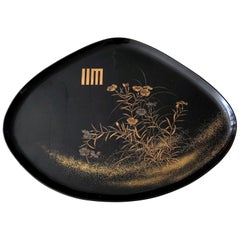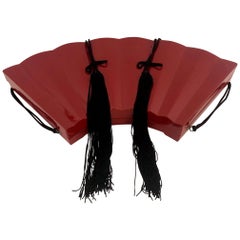Georgia - Lacquer
62
1
to
3
63
419
166
63
63
63
1
1
10
36
16
1
12
1
1
3
1
59
44
8
5
4
62
59
54
4
3
Item Ships From: Georgia
Japanese Namban Lacquer and Inlay Coffer Momoyama Period
Located in Atlanta, GA
A rare Japanese Namban Lacquer domed coffer circa 1570-1610s of Azuchi-Momoyama to early Edo period. These types of lacquerware were made for export to ...
Category
16th Century Japanese Japonisme Antique Georgia - Lacquer
Materials
Wood, Lacquer
Large Vintage Japanese Maki-e Lacquer Kimono Tray
Located in Atlanta, GA
A large square lacquer presentation tray (likely for kimono) predated 1950 of the Showa period. Elaborately decorated with Maki-e that depicts the prunus blossom, bamboo and needle p...
Category
1940s Japanese Japonisme Vintage Georgia - Lacquer
Materials
Wood, Lacquer
Rhino Contemporary Japanese Lacquer Art by Someya Satoshi
Located in Atlanta, GA
Japanese Lacquer Rhino Sculpture by Someya Satoshi (1983-). A hand-molded lacquer sculpture that depicts a fantasy beast "Rhino". The artist uses century-old traditional techniques and symbols but with an innovative contemporary energy that borders mysticism, shamanism and surrealism. Found objects were equally treated as part of the meticulous designs as the elaborate Maki-e and shell inlays.
According to the press of Honolulu Museum of Art: "Someya Satoshi has been described as “one of the most significant contemporary lacquer artists working in Japan today.” (Japan Times, 12 Dec. 2013) His work combines objects of daily use, such as bathing buckets, serving trays, and soup bowls, with a wide array of natural materials, including animal bones, horns and antlers, sand, stones, leaves and branches. In the process, he implements a range of traditional lacquer methods passed down from pre-modern eras, such as the kanshitsu or “dry lacquer” technique, the origins of which date to Japan’s Nara period (710–784). After creating his forms, he embellishes them with designs inspired by calligraphy, traditional Japanese textile patterns, and even contemporary manga or comic books. His work defies ordinary definitions of lacquer art and successfully challenges the perceived limits of this extremely difficult and, in some ways, most conservative of traditional Japanese art forms".
His work was exhibited in US such as Honolulu Museum of Art, Minneapolis Institute of Art, Morikami Museum etc. For a complete resume of the artist, see the artist's page in Imura Art Gallery.
Reference: For a very similar Bull Sculpture see Hard Bodies Contemporary Japanese Lacquer...
Category
Early 2000s Japanese Japonisme Georgia - Lacquer
Materials
Rope, Wood, Lacquer
An Antique Japanese Lacquer Maki-e Tray
Located in Atlanta, GA
A fan shape black lacquer tray from Japan circa 1910-30s, late Meiji to early Showa era. Elaborated decorated with a bundle of yomogi blossom in a very fine Maki-e technique using both gold and silver powders. There is a Japanese symbol on the top left, which represents yomogiu, stemming from yomogi (蓬), a wild plant that belongs to the chrysanthemum family and widely grown in Japan.
This name yomogui is from a scene in the Tale of Genji...
Category
Early 20th Century Japanese Japonisme Georgia - Lacquer
Materials
Lacquer
Japanese Lacquer Ware Fan-Shaped Box with Compartments
Located in Atlanta, GA
A Japanese fan-shaped lacquer box with tassels, red exterior with slightly scalloped cover. The interior is fitted with seven smaller fan-shaped trays ...
Category
20th Century Japanese Japonisme Georgia - Lacquer
Materials
Lacquer
Recently Viewed
View AllMore Ways To Browse
Chinese Cinnabar Red And Black
Japanese Ink Stone
Antique Chinese Cinnabar Lacquer
Antique Japanese Inro
Asian Music Box
Silver Miniature Asian
Negoro Lacquer
19th Century Carved Chinese Fan
Gold Flying Cranes
Lacquer Offering Bowl
Chinese Lacquerware
Water Dropper
Japanese Comb
Japanese Cinnabar
Japanese Lacquered Miniature
Japanese Lacquer Document Box
Japanese Lacquer Plaque
Burmese Lacquer Trays




